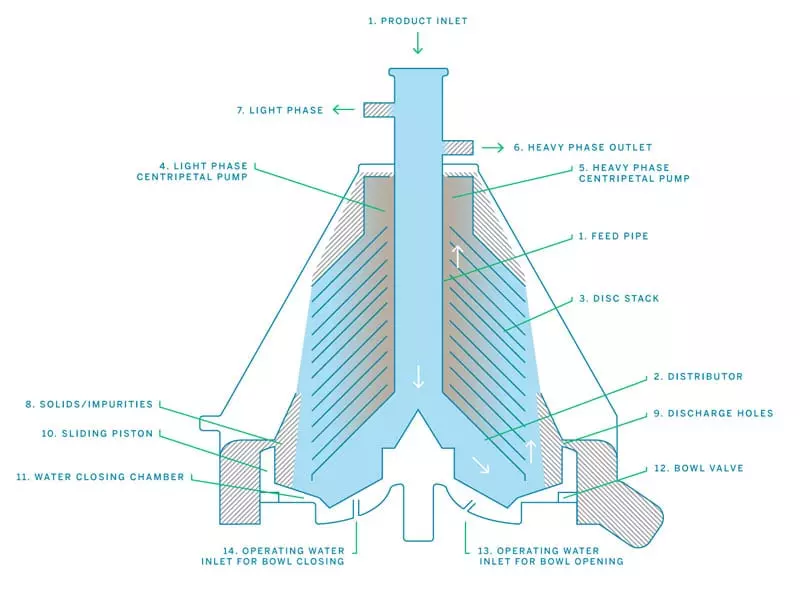
How Three-Phase Separators Work: An Overview


One of the key defining differences among industrial centrifuges is between “two-phase separators” and “three-phase separators.”
In practical terms, two-phase separators are generally used to separate liquids and solids—for example, pulling metal fines or sludge from your cutting fluid (i.e., “liquid/solid separation”). But if you wanted to remove both fines and separate two liquid phases—for example, tramp water and cutting oil—you’d need a three-phase separator, which separates a liquid from a liquid from a solid (i.e., liquid/liquid/solid separation).
There are many different styles of centrifuges, each suitable for a wide variety of tasks—screen/scroll centrifuges, large decanter separators, tubular bowl centrifuges, filter centrifuges, fixed-angle centrifuges, analytical ultracentrifuges, and more.
But when it comes to industrial three-phase separation, conical plate centrifuges (also called disc bowl centrifuges or disc stack separators) are of special interest.
As we’ve discussed in previous posts, a centrifuge is basically an accelerated settling tank. The outside of the centrifuge’s vessel serves as the settling surface where the densest material collects. In many industrial centrifuges (such as those with a tubular bowl), the overall shape of the vessel is such that denser material (usually particulate) collects and is forced out of one end of the centrifuge, while less dense material flows out the other: two ends, two phases of separation.
Disc Stack Centrifuges: The Ideal Three Phase Separator
A disc stack separator is different. As you can see in the diagram below, it actually has two outlets (both at the top, labeled #6 and #7), and a separate solids collection and discharge at the bottom (see #8 and #9 in the diagram). Hence the three-phase operation—two different liquid phases at the top outlets, and sludge or other solid particles from the lower discharge.

The key element is the “disc stack” (labeled #3), for which this style of the separator is named. The disc stack is a series of cone-shaped plates. These are arranged in a vertical stack inside of the centrifuge vessel, increasing the amount of settling surface available within the tank. Having a greater settling surface doesn’t just speed the separation process and decrease retention time. It also gives us a great deal of fine control over what’s happening inside the separator. This enhanced control makes it possible to separate several phases in a single pass. By changing the stack arrangement, angle, spacing, and shape, you can accurately control how materials are separated and adjust for changes in fluid flow and composition.
Trucent’s disc stack centrifuges can dynamically switch between three-phase and two-phase operation. A single unit can take on tough three-phase tasks with admirable efficiency (generally separating with roughly 70 percent efficiency on a single pass). But if you find yourself needing to run a simpler liquid/solid separation, you can switch to two-phase operation, and bump up to nearly 90 percent efficiency on a single pass.

Client-Site Services
Committed to Service
With the largest fleet of separation technology, advanced engineering, and chemistry capability across a wide array of industries and experienced operations personnel throughout North America, you can count on us when you need us most.
- 9 Service Locations Across North America
- The Largest Fleet of Separation Technology
- Over 150 of Fluid Experience





